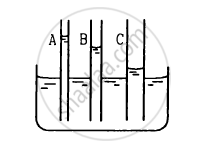Advertisements
Advertisements
Question
Define the surface tension of a liquid.
Solution
Surface tension is defined as the force acting on a unit length of an imaginary line drawn on the free surface of the liquid, the direction of the force being perpendicular to the line so drawn and acting parallel to the surface.
APPEARS IN
RELATED QUESTIONS
Explain why A drop of liquid under no external forces is always spherical in shape
Show that the surface tension of a liquid is numerically equal to the surface energy per unit
area.
It is said that a liquid rises or is depressed in capillary due to the surface tension. If a liquid neither rises nor depresses in a capillary, can we conclude that the surface tension of the liquid is zero?
Water near the bed of a deep river is quiet while that near the surface flows. Give reasons.
If more air is pushed in a soap bubble, the pressure in it
The capillaries shown in figure have inner radii 0.5 mm, 1.0 mm and 1.5 mm respectively. The liquid in the beaker is water. Find the heights of water level in the capillaries. The surface tension of water is 7.5 × 10−2 N m−1.

Find the force exerted by the water on a 2 m2 plane surface of a large stone placed at the bottom of a sea 500 m deep. Does the force depend on the orientation of the surface?
A cubical block of wood weighing 200 g has a lead piece fastened underneath. Find the mass of the lead piece which will just allow the block to float in water. Specific gravity of wood is 0.8 and that of lead is 11.3.
How does surface tension help a plant?
Define the angle of contact for a given pair of solid and liquid.
